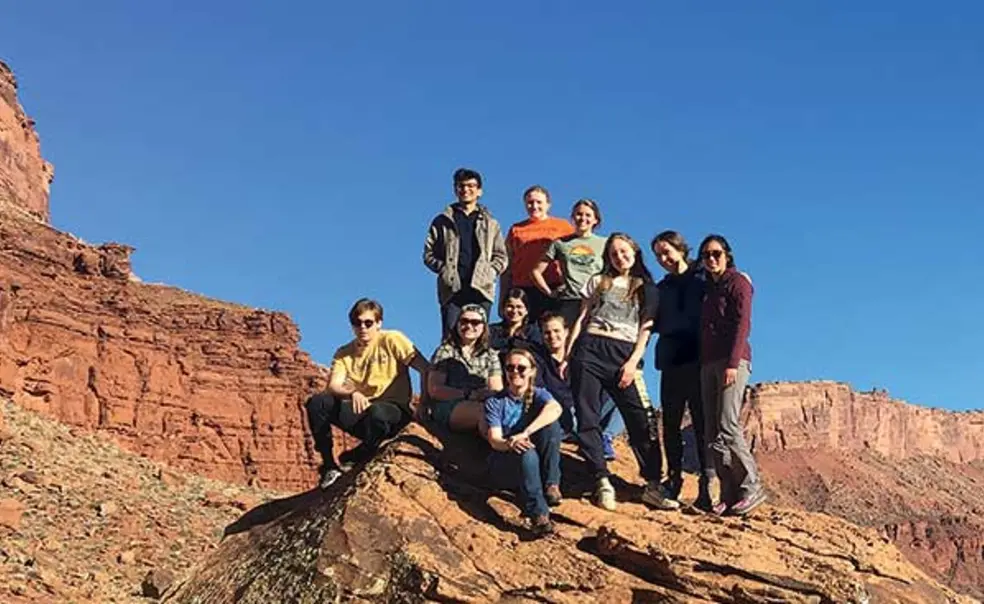Monumental Dispute
Students on a class trip to Bears Ears hear the stories behind the issues
Among the class trips during spring break was one that sent students to southeastern Utah to explore the historic, cultural, and natural-resource issues at the heart of the dispute over Bears Ears National Monument. Peter Schmidt ’20, a PAW intern, reports on the weeklong event:
“I wanted to bring you here so you can understand what happened to my family,” Ida Yellowman said, squinting against the midafternoon sun. My classmates and I were in Aneth, Utah, a sparsely populated expanse of rolling hills speckled with sagebrush and bordered by precipitous sandstone bluffs.
Beside the toppled stones that marked the foundation of her grandmother’s old home, Yellowman told us how her grandmother would bring the family’s herd of sheep into the pen at night — and as soon as she went inside to cook, the sheep would escape the pen and bound up the rocky slope behind their house.
We looked up the hill and saw the silhouette of a petroleum pumpjack, bobbing up and down in concert with dozens like it, extending across the landscape as far as we could see. Because the oil industry had acquired most of the land in Aneth, Yellowman and her family years ago had been forced to move nearly 50 miles away.
We were here as part of a Princeton Environmental Institute course called “Exposure: The Storied Landscape of Bears Ears National Monument,” which explored the complex relationships between land sovereignty, extractive industry, Native rights, and storytelling in the American Southwest. Over the course of a seven-day spring-break trip to southeastern Utah, we met with conservationists, Native activists, local politicians, and residents to better understand the multi-layered controversy surrounding Bears Ears and the people who live there.
In December 2016, President Barack Obama used the 1906 Antiquities Act to create the Bears Ears National Monument, a 1.35-million-acre monument in the Four Corners region, which enclosed a landscape sacred to various Native American traditions. One year later, President Donald Trump reduced the area of the monument by 85 percent through executive order, an action that is being challenged in the courts.
Audio Feature: Princeton Students Visit Bears Ears
The course is led by Fazal Sheikh ’87, an award-winning photographer and former MacArthur fellow who is a visiting professor at Princeton. He has worked in the Bears Ears region for nearly two years, and he brought students to the area to practice what he calls “ground-truthing”: understanding the political controversy surrounding the land by meeting the people who call it home.
The complexity of the Bears Ears controversy was most evident in a town hall meeting with Rep. John Curtis, R-Utah, in the small town of Bluff. The town sits on the divide between the Navajo reservation to the south and the white majority-Mormon communities of Monticello and Blanding to the north.
The primary issue on the table was the future of the Bears Ears Monument. Members of each community sat apart from each other with arms crossed, and what they had to say, although courteous, conveyed their frustration with the ongoing controversy.
We met with conservationists, Native activists, local politicians, and residents to better understand the multi-layered controversy surrounding Bears Ears and the people who live there.
A farmer from White Mesa expressed his opposition to the monument, saying, “I’m familiar with acreage — 1.9 million acres is insane. Why do you need so much?”
In response, Willie Grayeyes, one of the county’s three newly elected commissioners, called for the microphone. “The folks here in this county — especially the white folks — want to sell the land. For some reason ... they love oil- and gas-industry production more than ancient sites [within Bears Ears]. I want to bring the fact to you that these places are real. They’re as real as the Mormon Temple in Salt Lake City.”
For Kate Schassler ’21, witnessing the town-hall discussion made the political controversy surrounding Bears Ears more tangible. After being in the area for only a few days, “I looked around and knew so many people in the room,” she said. “That was something that struck me: the number of people in this community that were involved. This issue really is interpersonal.”
The class also spent a morning climbing Comb Ridge, an 80-mile-long formation rising from the desert floor like a sandstone wave. Every so often, our guide would stop and indicate shards of ancient Pueblo pottery glittering in the red earth. At the top of the ridge, in the shadow of an overhang, he showed us a Pueblo rock panel depicting 179 human-like figures as well as mountain sheep, elk, and snakes. “This area is the most culturally dense place in the United States,” he told us.
After returning to campus, students worked to crystallize these encounters into an exhibit planned for the Lewis arts complex and a ceremonial gathering, which was scheduled to be held in early May. The exhibit, focusing on the history of Bears Ears and indigenous rights, was expected to include students’ photographs, Native items in the University’s art collection, and information on extractive industries in the Bears Ears region.
The ceremonial gathering, to which representatives of various Native groups were invited, was intended to symbolize a renewed commitment to conversation and cooperation between Princeton and Native communities.












No responses yet